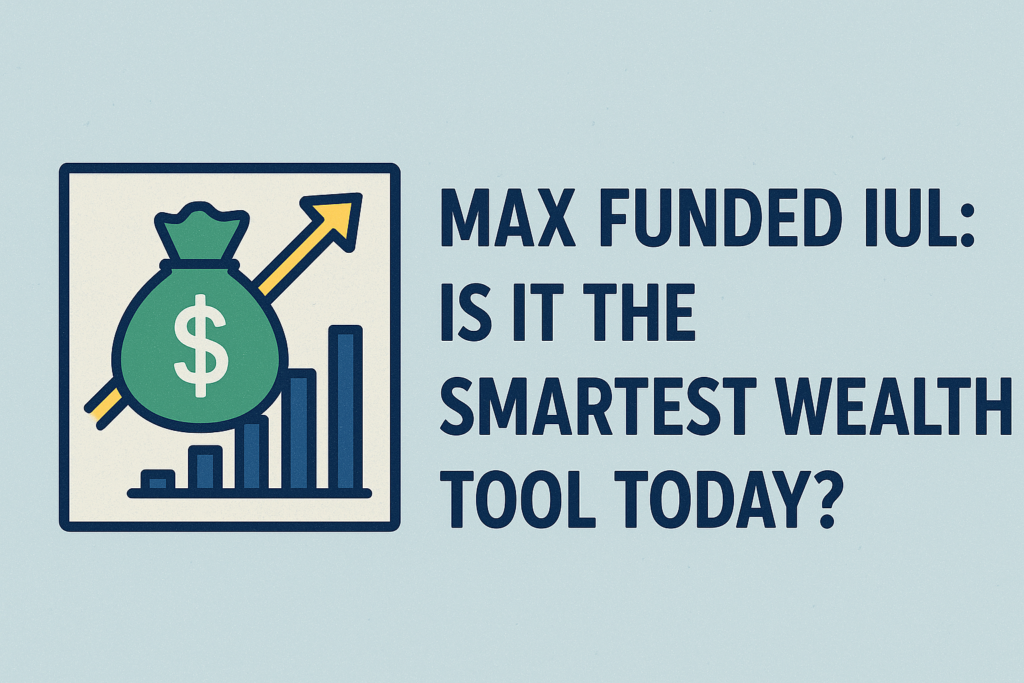
Key Takeaways
- Max Funded IULs combine life insurance with a tax-advantaged savings component that grows based on stock index performance.
- Overfunding the policy maximizes cash value growth while minimizing insurance costs, creating a highly efficient wealth-building tool.
- Offers tax-free growth and withdrawals when structured correctly, making it an attractive alternative or supplement to IRAs and 401(k)s.
- Provides market-linked gains with downside protection, thanks to caps and floors on returns.
Introduction
In the ever-evolving landscape of financial planning, one tool has been steadily gaining attention for its combination of protection, growth potential, and tax advantages: the Max Funded Indexed Universal Life Insurance (IUL) policy.
What Is A Max Funded IUL?
An Indexed Universal Life (IUL) insurance policy is a type of permanent life insurance that offers both a death benefit and a cash value component, which grows over time based on the performance of a stock market index (such as the S&P 500).
How Does It Work?
- Premiums are paid into the policy.
- After covering the cost of insurance and administrative fees, the rest goes into the cash value account.
- This cash value earns interest based on a market index, but without being directly invested in the market.
- The account is protected by a “floor” (typically 0%) meaning you won’t lose value in a down market, and a “cap” (often around 8–12%) which limits the maximum gain in a given period.
- You can access the cash value tax-free through policy loans or withdrawals (if structured properly).
When max funding, the aim is to minimize the cost of insurance by keeping the death benefit as low as IRS rules allow, while maximizing cash value contributions.
Also Read: Tech News FeedWorldTech: Breaking the Latest in Innovation
Why Is It So Popular?

Let’s look at the major benefits that have positioned the Max Funded IUL as a contender for the smartest wealth-building tool:
1. Tax-Free Growth and Access
- The money inside a max funded IUL grows tax-deferred.
- Withdrawals and loans from the policy can be taken income tax-free, assuming the policy remains in force.
- No required minimum distributions (RMDs), unlike traditional retirement accounts.
This makes it a powerful tax-free retirement income strategy, especially for high-income earners looking for alternatives beyond IRAs and 401(k)s.
2. Market-Linked Growth With Downside Protection
- You participate in market upside through indexing, without risking principal in a downturn.
- The 0% floor prevents market losses.
- Some policies offer multipliers or bonuses that enhance returns.
This balance of risk and reward is particularly attractive in a volatile economic environment.
3. Liquidity And Flexibility
- You can access the cash value at any time, for any reason.
- There are no penalties for early withdrawals, unlike retirement accounts with age restrictions.
- Policy loans are not taxed as long as the policy stays in force.
This makes a max funded IUL ideal for emergencies, opportunities, or supplemental income.
4. Legacy And Protection
- As a life insurance policy, it naturally provides a death benefit.
- This benefit can be used to leave a legacy, cover estate taxes, or provide liquidity to heirs.
- The death benefit can also be accelerated for chronic or terminal illness, depending on the policy.
Also Read: Doctorhub360.com Neurological Diseases: Signs & Support
Who Is It Best For?
While almost anyone can benefit from an IUL, max funding requires discretionary income and a long-term mindset. Ideal candidates include:
- High-income professionals and business owners who have maxed out traditional retirement plans.
- Real estate investors or entrepreneurs who want a place to store cash with liquidity and tax advantages.
- Families looking for a legacy strategy combined with living benefits.
- Those wary of market volatility, but still seeking competitive returns.
Common Criticisms And Misconceptions

Despite its benefits, the max funded IUL is not without its controversies and misunderstandings.
1. “It’s Too Expensive”
It’s true that poorly structured IULs with high insurance costs and low funding can be inefficient. But a properly max funded policy minimizes insurance costs, making it a competitive alternative to other investment vehicles. The key is working with a knowledgeable advisor who specializes in IUL design.
2. “Returns Are Capped”
Yes, the upside is capped. However, the absence of downside loss and the compound interest effect over time can still yield solid returns. Plus, advanced policies now offer uncapped strategies or performance enhancers to mitigate this limitation.
3. “It’s Too Complicated”
Compared to a savings account or mutual fund, yes—it’s more complex. But complexity doesn’t mean inefficiency. With proper guidance, policyholders can unlock significant long-term advantages. Complexity is often the price of flexibility and customization.
Also Read: Luuxly.com Style: Elevate Your Life with Luxe & Innovation
Is It the Smartest Wealth Tool Today?
The answer depends on your goals. If you’re looking for:
- Tax-free retirement income
- Market-like growth without the risk
- Liquidity and control
- Protection for your family and estate
Then yes, a max funded IUL could be one of the smartest, most versatile wealth tools available today. However, it’s not a one-size-fits-all solution. It requires discipline, patience, and proper structuring.
Final Thoughts
A Max Funded IUL isn’t just life insurance—it’s a strategic wealth-building tool. In a financial world plagued by taxes, volatility, and uncertainty, this hybrid solution offers stability, tax advantages, and flexibility that few alternatives can match.
Still, success depends on working with the right advisor, understanding the structure, and maintaining the policy over time. When done right, it can serve as a powerful pillar in your long-term financial strategy.
Is it the smartest wealth tool today? For many—especially those who want control, safety, and tax-free growth—it just might be.





